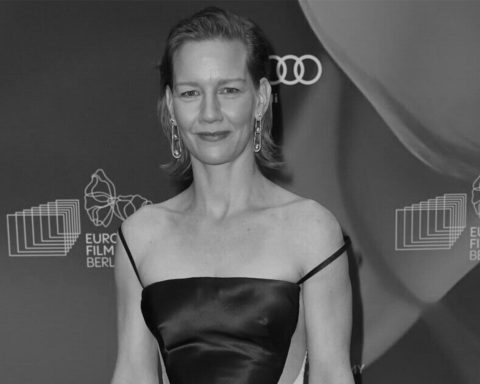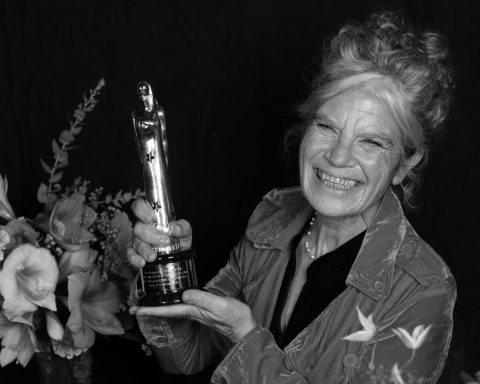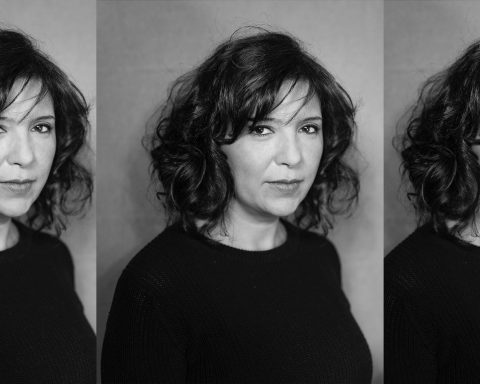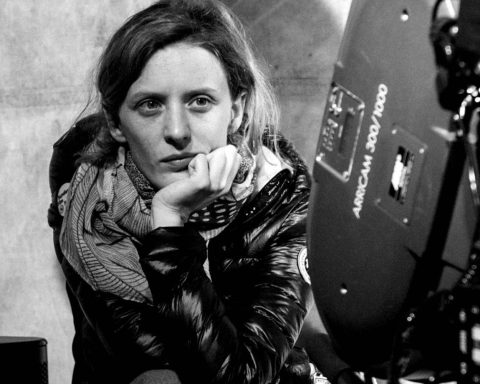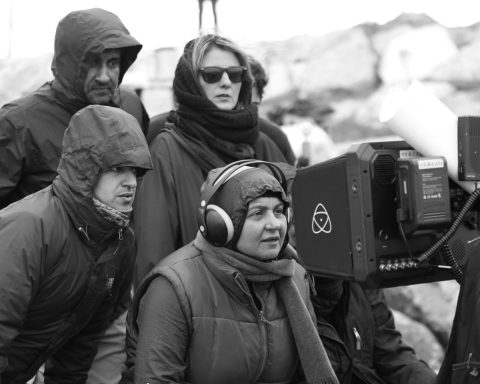Sandra Beerends has always loved stories; to hear them, tell them, imagine them, read them… Her mother taught her to read before she even stepped foot into a school. When she was nine years old, they made an exception for her at the local library so that she could borrow books from the adult department because she had already read all the children’s books. Logic then dictated that she studied Dutch Literature and she did and loved it. A long and sinuous path that included a Master’s in Theater Sciences and Dramaturgy and work as a TV production assistant, assistant director, all-round producer for all kinds of programs and story editor led her to what she is today: a script editor, creative producer and writer-director. The turning point came when she felt the urge to tell a personal story about the WWII traumas of her Indonesian mother and the impact Japanese camps had on her, which resulted in the short film, “Arigato,” that she wrote, co-produced and financed. Beerends now works for the Dutch broadcaster NTR and runs her own company, Beruang. Her work also includes the script-editing of “Kauwboy” by Boudewijn Koole and “In Blue” by Jaap van Heusden.
Her debut feature, “They Call Me Babu,” told gracefully and poetically in archive footage is a homage to Indonesian nannies – or babus – for colonial Dutch families at the time of WWII and the struggle for independence in Indonesia.
How did They Call Me Babu come about? What inspired you to make a film about the figure of the babu?
Sandra Beerends: My Indonesian mom used to tell me heartwarming stories about her babu, her nanny, who took care of her, twenty-four hours a day, from the moment she opened her eyes in the morning until the evening when she was sung asleep by her. Later on, I heard similar stories of other people who were raised by their Indonesian nannies, who loved them as “mothers.” They were the bridge between the Dutch culture and the Indonesian culture. When I asked them if they had ever seen their babus after the war, they would all get very emotional. The kids and their nannies were suddenly separated when they were put in Japanese camps. After the war, the independence war started and the Dutch had to return to the Netherlands. Later on, when they – as grown-ups – went looking for their babus in Indonesia, they could not find them. One of the reasons was that they didn’t know their real names; they knew their nanny as “babu” like a kid knows his mother as “mom.”
I was intrigued by these women who were not visible in our History. How they coped during this time, torn between two cultures, an “almost” member of the Dutch family they were working for, but belonging to the Indonesian people; loving a Dutch kid, but longing for Indonesian independence. What was the story of these almost forgotten women?
I wanted to give them a voice, a face. I wanted to get them out of the shadows. I wanted to tell their story from their perspective.
What was the research process like and what sources did you use?
S.B.: The first problem of researching images of babus, was that the keyword “babu” did not exist.
I have to say something about this word. It was a word used by the Dutch for their nannies in the former colony of The Dutch East Indies. For me, the word felt as a round motherly word. But in present Indonesia, the word is seen as an insult and they use the word “pembantu,” a common word for “servant.” So, I had to look for keywords like “servants,” “daily life,” or “family trips around the island.”
I knew Dutch families used to make their own home movies to show their life in the colony and send them to their family in the Netherlands. So, I saw hundreds of home movies. Yet, despite her central role in the family, she was not the main focus in these home movies. She was often in the edge of the frame, hiding in the background, or just recognizable as a hand that feeds the child, a scarf passing by. Finally, I found one family who did film her as well and I was very happy to interview a ninety-three-year old woman who was Jantje’s older sister, Tilly, in the film and she told me a lot about her babu.
But besides her daily life in the Dutch family, I also had to look for her daily life without them. So, I have seen all kind of films: corporate films of tea, rice, kapok, anthropological films, travel films, journals, Dutch, Indonesian and Japanese propaganda films.
Using archive material meant I had no control over the shots. The frame, the focus, the length. So, sometimes, I had a beautiful shot, but far too short! Or, the scene or subject I was interested in was only partly seen, or it had a stupid frame in the form of binoculars, very popular in those times! Most of the films were without original sound. And when they were with sound, it was most of the times some dominant music with a voice over or even propaganda.
That meant we had to make all the sounds ourselves, like the sound of gulping mud in the rice fields or the fluttering of flags. The good thing about looking at the images without sound, especially in propaganda films, is that you can really focus on the images. What do they tell? Like the scene in which Indonesian young women are singing Japanese songs. The voiceover tells you that the Indonesian people embrace the Japanese culture, but if you look at their faces, you can see how sad they look.
Also, the different frame rates could give you a disturbed reality. Like in the scene when the body of Alima’s dead mom is washed by the women. For me, it felt like they did not do it in the caring and loving way I expected. It was rough and quick. And then, we discovered it was played with much more speed than in reality.
In the edit, we worked with “preview only” material. I had the privilege that the two big Dutch archives Eye and Sound & Vision were involved from the beginning and besides their enthusiastic research for material, they rescanned the material, so I had the best quality for the final edit. But when I saw the newly scanned material, I discovered things I did not see before, which urged me to change the voiceover: like, for instance, I had a text about Jantje enjoying running in the garden barefoot. And then, I suddenly saw he was wearing shoes!
So, the research and the edit were monastic work, but after the edit, it was also a huge job to make all these different framerates, framing, color, material into one film. But It was a pleasure.
With the film, you give a voice to the voiceless and overlooked, and tell the Indonesian side of the story and History. Would you agree with that assumption?
S.B.: I would.
Using the oral histories to inform the narrative and narration of the documentary, you rewrite History in a way, and propose a revisionist view of History?
S.B.: My intention was not to rewrite History, but add a forgotten, hardly known part of it, from a different perspective, the perspective of a young Indonesian woman, with no knowledge or position to make a difference in the change of powers around her. But she had to deal with the impact of this powerplay around her, and she did this in her own way. I focused on the human and universal relationships in a time when different “rulers” put their flags to own the land, the people and History. I tried to present History consequently from her perspective without the judgement of the present knowledge about colonies and wars.
Who is Alima?
S.B.: Alima is based on dozens of stories of babus. I interviewed former babus, their children and grandchildren and children who were raised by babus, and I spoke to anthropologists who interviewed former babus and collected all these oral histories. I chose to make one story out of all these stories, told by one character, Alima. I really wanted the spectator to feel how she feels from her position in that confusing time and given the fact that there are hardly any former babus alive, I did not want other people to talk “about them.” It was important for me to give them a voice of their own. Storywise, it gave me the opportunity to use a wide range of beautiful stories fused together as one story. The stories of the babus are stories of brave women, of emancipation.
How do you see them? How do you think your film contributes to a change of perspective on the figure of the babu, and by extension of Indonesian women?
S.B.: I was triggered by the huge impact these “mother figures” had on the lives of the children they took care of. All of the kids felt a deep love when they talked about their babu and underneath, there was the love for her country, her culture, the food, the stories, the sounds and smells of her homeland, their birthland. When I started researching, I was just thinking of them as lovely “mothers.” When I found out that Indonesian people see the word “babu” as an insult, I felt ashamed and thought of them as pitiful abused women, but my opinion completely changed when I spoke to the child of a former babu. “She was analphabetic, but she could read her environment” he said. “She knew exactly how to talk, to dress, to behave. She was a survivor.” And for the first time, I saw how brave they must have been, these young women, coming to the Netherlands with an unknown family, to an unknown country with an unknown culture and an unknown language. Later, I discovered there was a “babu house” in the Hague, founded by a Christian association to help the babus who were abandoned by Dutch families, but developed into a kind of employment agency for babus and who rented their services as nannies on the boat trip to Dutch Indonesia and back. They were the first ZZPers, the Dutch word for self-employees. Unfortunately, in the end, there was no place for this story of women empowerment.
In the time of this film, there was the “adat,” a set of rules how to behave in society. One of the rules for women was that they were expected to contribute to the work of their husband, meaning they were not really “working,” but “helping their husband” and so, the owners of the rice fields did not see them as employers and didn’t have to pay them, but gave them a rice bundle. The images I found of the rice fields were very romantic, women and girls working side by side with beautiful volcanoes in the background. So, I asked the sound designers to communicate in sound how heavy – constantly leaning forward –, muddy and soaking this kind of work was.
In the film, Alima finds courage to follow her dream, her own way through the confidence of her mother in her, despite her limited possibilities as a girl. I was criticized by a male producer about the credibility of her development from a young poor girl to a self-conscious woman as if young poor girls didn’t have the possibility or the longing to be more than the role society – men – had decided for you.
I heard a story of a babu who ran away from an arranged marriage and who was asked by her Dutch family to join them after the war to the Netherlands. “I think I am needed here,” she responded. “I want to dedicate my life to the education of girls.” After her death, this family got a letter from her friend that after the founding of schools for girls, she ended her working life in the ministry of education. I believe that little sparks of hope and trust can lead to making steps towards your dream.
What have you learnt while making They Call Me Babu?
S.B.: As a director, it is important to rely on your inner drive to make this film, choose people who share your vision of the story so there is room for their contribution and experience to make the story and the way the story is told on the highest level.
Are you a feminist? If so, how does this inform your filmmaking?
S.B.: I have never thought of myself as a “feminist.” I am not into putting labels on people. In my opinion, it kind of narrows people as human beings. I like small deeds rather than big words. But I am a woman and I am very happy to be a woman and, of course, I don’t like to be patronized by men, especially when they act out of power instead of knowledge. So, I am not the one in the front of a political march, but in daily life, raising my three kids and working as a script editor, it feels like a natural topic to treat women the same way as men and fictionwise, make them full-fledged interesting characters. So, in They Call Me Babu, I felt the urge to tell the story of the babus because they are totally neglected in our History, because History is mostly written by and about men.
What subjects interest you and that you would like to tackle in your work? What would you like audiences to come away with after watching your films?
S.B.: I think I am mostly interested in ordinary people making choices out of humanity, doing great things without making a lot of fuss. And I like to give them a stage in my film because they are not in the position to do it themselves.
Who is your favorite female filmmaker and your favorite film by a female filmmaker?
S.B.: I am sorry, but I am not person of lists and I always forget titles and names, so I can only give you a title and a name that just pop up – now that you ask me – of a film that really touched me: The Piano by Jane Campion. I was overwhelmed by the beautiful images of the nature that she also uses as a metaphor for the difference between the European and indigenous cultures, the clash between the head, the rules and the body, the intuition, the unsaid. For me, it is also about interesting female characters. La vie devant soi with Simone Signoret is one of my favorites. It is such a beautiful universal story of the trauma of war and the love of an Arabic child for the Jewish “mom” that raised him.
There has been a lot of talk about the situation of women in the film industry these past two and a half years. What is your take on the matter? How is it in the Netherlands?
S.B.: I think it is good to be aware and ask attention on unconscious bias and diversity in a wider scope. When you work as a script editor, it is always a topic when we talk about the story, the characters and the cast. In the Netherlands, there are a lot of great female film directors like Dana Nechushtan, Nanouk Leopold, Sacha Polak, Mijke de Jong, Heddy Honigmann to name a few, but on the other side, in the Film Academy, male directors are still the majority. For the crew of They Call Me Babu, I did not especially choose it based on gender. So, for the edit, the music and the sound design I found great people who were interested in my story and would contribute with their talent to my vision of the story. And they happened to be men. I found it interesting to see that on some topics like war, politics or motherhood there was a difference between their male perspective and my female perspective. It sharpened my thoughts and feelings and made me extra alert of my choices in the film. And I don’t think a story of a woman can only be made by a crew of women. And I found a kind of proof in the music Alex [Simu] made in the mother-child theme. He translated my feeling towards this theme in his music.
What are your next projects?
S.B.: My next project is still bubbling inside me: images, thoughts, ideas… And it is not developed enough to share with other people. I use the prize money from the Dokfest Award to research it for myself, at my own pace – like a kind of creative pregnancy.
This interview was conducted in partnership with:

and:







